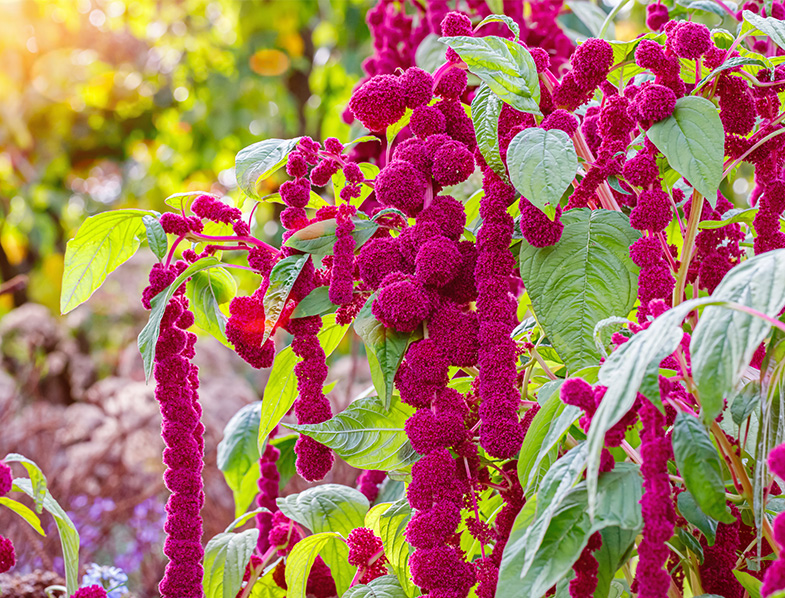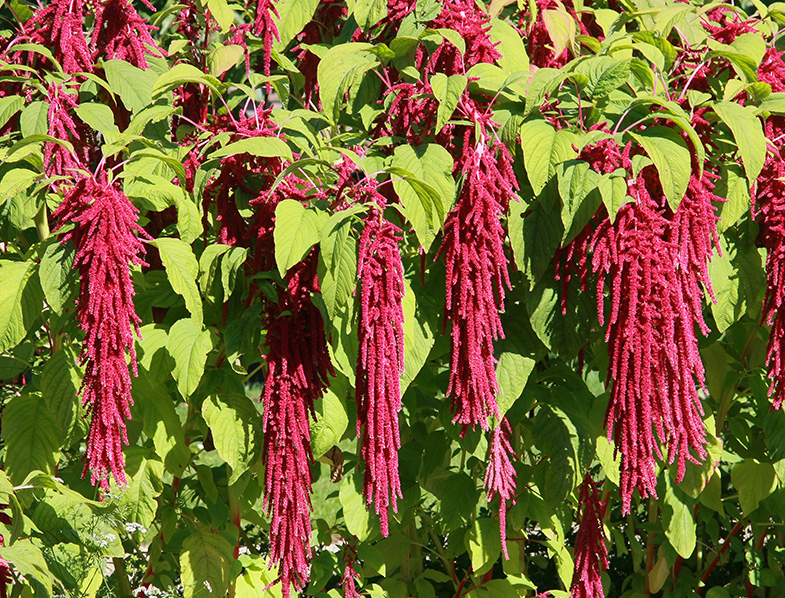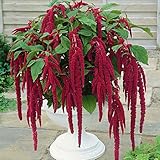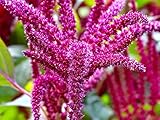If you are looking for an eclectic annual plant that will give your garden an exotic vibe, you cannot go wrong with Amaranthus Caudatus.
Also known as Love-lies-bleeding, tassel flower, purple amaranth, pendant amaranth, Quilete, foxtail amaranth, or velvet flower, this hanging beauty has many uses. It belongs to the Amaranth genus which contains about 60 species that can be found all over the world.
People have grown the Caudatus variety for a long time beacuse it has edible leaves and seeds. More recently, however, this lovely plant became popular for its ornamental purposes.
Aside from its culinary applications (it is considered a superfood), this plant also has some amazing medicinal properties. Moreover, due to its intense colors, Love-lies-bleeding ywill attract a lot of natural pollinators in your gardens like butterflies and hummingbirds.
About Amaranthus Caudatus
- Love-lies-bleeding is native to the American tropics, but you can easily grow it in most parts of the world.
- Love-lies-bleeding is quite popular in North America. It prefers USDA zones 2-11.
- The name of this plant comes from the Greek word “amarantos” which means unfading. This refers to the plant’s long-lasting flowers. Caudatus is a medieval Latin term that means “tail” or “having a tail”. This term refers to the dropping flowers which look like tails.
- The intense plum or pink shades displayed by the flowers of this plant are given by a high content of betalain, a compound that is also present in the common beet.
- As an ornamental plant, Purple Amaranth was introduced in Europe in the 16th century, but it became truly famous during Victorian timers. It symbolizes hopeless love, which is why it is often used for wedding centerpieces and flower arrangements.
- Amaranth was a very important crop for Aztecs and Incas. Nowadays, they grow it mostly for its highly nutritious seeds.
- A plant can bear up to 100,000 seeds. You can cook them or grind them into a powder. You can also pop them like popcorn. They contain a lot of proteins, as well as calcium, iron, potassium, vitamin E, and several other nutrients.
- Being gluten-free, amaranth seeds are a great option for people who suffer from Celiac disease. In Indonesia and Malaysia, people consume the plant’s leaves and use them as a spinach alternative.
- While this plant is not toxic, if it grows in nitrogen-rich soils, its leaves will contain high levels of nitrates. Nitrate is linked to numerous diseases including cancer.
- In many parts of the tropics, Love-lies-bleeding is a weed, but it is not particularly invasive.
- The purple Amaranth is quite resilient, and it is not susceptible to diseases. Nonetheless, it is frequently attacked by pests that chew on its leaves.
- Other uses for the Amaranth flowers include red food coloring. Furthermore, the whole plant can be used to obtain green or yellow dies.
- Amaranth has a long history of being used as a medicinal plant. Recent research has shown that it is very effective in treating Diabetes mellitus, malaria, cancer, atherosclerosis, bacterial infections, hepatic diseases, cardiovascular problems, and inflammation.

Amaranthus Caudatus Features: An Overview
- This is a tall plant that will add verticality to your garden. It can grow between 1m and 2,5 m tall. When it gets heavy with seeds, it may need stalking, so it does not collapse under its weight. It can reach an average spread of half a meter. Love-lies-bleeding does not mind growing in crowded places so you can space plants about half a meter apart.
- The flowers can retain their intense purple shade for up to 10 weeks. They have a panicle structure, meaning that they grow in a branched cluster. They bloom from summer until frost.
- The seeds face downwards, and it’s best to harvest them before they reach maturity, so that they are not wasted.
- The pendant amaranth is a Deciduous plant, meaning that it sheds its leaves annually. The leaves are lance-shaped, about 5-15 cm long.
- The leaves of Love-lies-bleeding are light green but can also be variegated at times. The petioles have the same length as the leaves, and they have a dark pink shade.
- This is a monoecious plant, meaning that the flower can be either female or male. Nonetheless, both flower sexes can be found on the same plant. It is a self-fertile plant that is usually pollinated by the wind.
Growing Amaranthus Caudatus
Despite this plant’s tropical nature, it grows well in temperate climates as well. Love-lies-bleeding thrives in areas where daytime temperatures range between 21°C and 28°C. In extreme conditions, it can tolerate temperatures ranging between 7°C and 40°C.
Amaranthus likes rich soil with good drainage and a pH range of 5,5 to 7,5, and it will thrive in a hot yet sheltered position. It is suitable for all soil types, but it grows better in well-drained soil. While this plant will tolerate droughts without problems, it cannot grow in the shade, so make sure to only shelter it from winds, not the sun.
Amaranthus Caudatus has a rather predictable growth behavior. As such, you can maintain it with ease, without having to resort to various containment methods.
- Amaranthus Red grows as an annual in USDA Zones: 3 - 10. This ornamental plant loves to be in full sun and is heat resistant.
- These heirloom seeds are great for planting in flower gardens or along borders as a contrast to other foliage plants. This easy to grow plant has red blooms on weeping stems.
- Amaranthus Caudatus, also known as Love Lies Bleeding is very tall, reaching a height of 36 inches and makes a wonderful cut flower or can be used for dried flower arrangements.
- The sowing rate for Red Amaranthus is 4 seeds per plant. Keep seeds moist until germination occurs.
- To grow Love Lies Bleeding Amaranthus flower seed, start seed indoors six weeks before transplanting outdoors. Should germ in about 2-3 weeks at 70 degrees F. Or start outside after all danger of frost has passed.
- A unique annual easy to grow plant with stems 40-60 inches tall, that creates an illusion of a fabulous waterfall; The plant is known for its nutritious and medicine qualities
- The young leaves of the plant are used in fresh salads and the older leaves can be used steamed or baked in dishes in the same way you would use spinach; The grains are high in protein and can be ground into flour
- The plant blooms abundantly and continuously from June to October and is drought-resistant once established; In ancient Greece the plant was as a symbol of immortality due to long lasting flowers
- Foxtail Amaranth that is also called love-lies-bleeding or pendant amaranth or tassel flower or velvet flower or quilete
- A great idea for a gift for Christmas stocking stuffer or a small addition to a birthday gift; or just to become more self-sustainable by creating a charming self-sufficient garden with fresh, home-grown vegetables, fruits and herbs or just beautiful flowers
- Common names: Amaranthus caudatus, Foxtail Amaranth, Love-Lies Bleeding, Tassel Flower, Velvet flower
- Annual, easy to grow plant with stems 40-60 inches tall, that creates an illusion of a fabulous waterfall
- The plant blooms abundantly and continuously from summer to frost and is drought-resistant once established
- The plant is edible; It is known for its nutritious and medicine qualities; The grains are high in protein and can be ground into flour
- The young leaves of the plant are used in fresh salads and the older leaves are steamed or baked in dishes in the same way you would use spinach
Last update on 2024-10-06 / Affiliate links / Images from Amazon Product Advertising API
As far as pest control goes, you can use garlic or lemon juice to repel ants. Caterpillars and aphids can be dislodged with water sprays. Keeping the pests at bay is not complicated, but you will have to check the plants regularly. You should also check for leaf spots and remove affected leaves in the early stages of decay.
Other than regular pest control, the purple amaranth is very low maintenance. It only requires weeding when it is young. As it grows, its shade will kill most of the summer weeds.
If you plan on harvesting your amaranth, make sure to choose the right time. Harvest time is usually announced by birds that start pecking at the amaranth seeds, but also by the seeds themselves which start falling when they are ripe. Choose a warm and dry day for harvesting the seeds. For this process, you will only need a bucket in which to catch the seed heads after clipping them off. Next, you simply strip off the seeds and separate them from the debris. Spread the seeds on trays indoors and allow them a few days to dry off completely.
Watering Amaranthus Caudatus
Being highly resistant to draughts, Amaranthus Caudatus is not demanding when it comes to watering. Twice a week is sufficient for adequate growth. However, during germination and pollination, you might want to water it more frequently. The rest of the time simply check the soil and water it when the soil is dry.

Propagating Amaranthus Caudatus
Amaranthus is very easy to propagate from seed and it has a very quick germination period. To start off, place the seeds on a warm seedbed. They should germinate in 2-3 weeks, after which you can safely move them to a permanent place.
When planting the seeds, make sure you barely cover them with soil. It is essential to keep the soil moist until the seeds sprout. You should sow the seeds in April or May, and plant them in June. Plant the seedlings in full sun, about half a meter apart. Before planting, enrich the soil with a balanced organic fertilizer. Keep in mind that inorganic fertilizers will affect the toxicity of the leaves, making them unsuitable for consumption. Thin the plants as they grow.
You can also propagate purple amaranth through cuttings. For this process, you will need a 15 cm long stem. Ideally, you should choose a young stem. Remove all leaves, except for the top 2-4 leaves. You can plant the cutting directly outdoors in spring once the soil has warmed up and there is no longer the risk of frosts. Simply bury the bottom 5 cm in the soil. Pres the soil around the cutting to give it support and then water it abundantly. You should water it a few times a week, until it grows some strong roots.
In Conclusion
Due to its moderate height, you can grow Amaranthus Caudatus in the middle row of flower borders. A great thing about these amazing flowers is that you can cut them for fresh or dried bouquets.
Love-lies-bleeding is ideal for English gardens, cutting gardens, but also cottage gardens. It is very low maintenance and easy to grow, so it is suitable even for beginner gardeners. As long as it gets direct sunlight and moderate watering, your Amaranthus will grow to its full potential.
The beauty of this plant is that it rewards you in many ways. It attracts beneficial pollinators, and its rich clusters of flowers will add a touch of color and texture to your garden. Moreover, even if you grow it for ornamental purposes, once the flowers fade, you can still harvest the seeds and use them for culinary purposes.
Love-lies-bleeding can be paired with almost any flower, but it looks particularly well when paired with chrysanthemums, sunflowers, or different types of wildflowers. It also goes well with Verbena and Pennisetum. Whether you grow it for its gorgeous dropping flowers or culinary properties, Love-lies-bleeding will surely be a nice addition to your garden.



